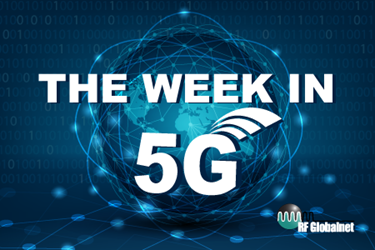The Week in 5G: 5/26/2020 —Huawei's "Breakthrough" Antenna; Shanghai's 5G Phone Booths
By Ed Biller

Starting Down Under, Australia’s Telstra has begun trialing mmWave 5G mobile phone technology as the telco touts its 5G network availability in more than 700 towns across the country.
Initially, Australia’s 5G networks were limited to lower-spectrum bands for which they already possessed licenses, reports The Guardian. Spectrum in the 3.6 GHz band has enabled 5g speeds double that of 4G thus far, but Telestra 5G partner Ericsson claims mmWave bands can enable speeds close to 4.3 gigabits per second, as measured in a lab test earlier this year.
Heading up north to the United Kingdom, Britain’s National Cyber Security Centre (NCSC) has announced it will again review Huawei's role in Britian’s 5G network, despite initially stating it would consider all options equally (including the Chinese telco whose equipment the United States warns is a security risk).
"Following the U.S. announcement of additional sanctions against Huawei, the NCSC is looking carefully at any impact they could have to the UK's networks," an NCSC spokesman told the BBC (per a Business Insider report).
Per the report, the US sanctions earlier in May “make it harder for chip manufacturers using US-made parts to sell to Huawei.”
In Canada, Prime Minister Justin Trudeau is yet to announce whether his government will ban or restrict Chinese Huawei from supplying 5G network gear. The Globe and Mail reports “Canada remains one of two members of the Five Eyes intelligence-pooling alliance – which includes the United States, Australia, New Zealand and Britain – that have not taken any action to ban or curb the Chinese telecommunications giant from supplying 5G equipment.”
The Thai government, meanwhile, has no concerns about working with Huawei, having enlisted the telco to help implement AI and 5G technology at hospitals, with the aim of performing medical diagnosis more efficiently.
Thailand’s government raised $3.2bn from 5G spectrum auctions in February, and the nation’s government has formed a 26-member national 5G committee to lead 5G rollouts in that nation, reports Computer Weekly. The committee will be chaired by Thai prime minister Prayut Chan-o-cha and will attempt to push through obstacles “related to the recall of unused spectrum from state agencies for the National Broadcasting and Telecommunications Commission (NBTC), in exchange for compensation.”
The committee also will promote cooperation between related agencies for 5G development and develop a roadmap for 5G adoption and infrastructure development,” states the report.
In addition to its recent network rollout wins, Huawei is touting what it calls a “breakthrough” 5G base station antenna design.
Per a report by PhoneArena, “to support the higher capacity and additional antenna connections used for 5G, the antennas deployed must be able to work with 1 KW of power; previous generations of wireless connectivity required only 500 to 600 Watts. CableFree increases the antenna power capacity by more than 80 percent to meet these requirements. CableFree also reduces the weight of the antennas… A six-band antenna using CableFree is over 22 pounds lighter and by keeping the weight of multi-band antennas under 110 pounds, a crane is not required during installation.”
The report also states that CableFree “reduces the use of screws and soldering points by 80% reducing the chance of passive intermodulation, or signal distortion and interference caused by large metal objects.”
Meanwhile, Swedich telecom Telia Company has launched commercial 5G in Stockholm, announced Ericsson, which provided Radio Access Network (RAN) products and solutions to the rollout.
“Initial services on the 700Mhz band will cover most of central Stockholm by mid-June, including the Norrmalm, Östermalm and Vasastan districts,” states the press release, adding that “Telia aims to enhance and supplement its low-band 5G commercial services with additional nationwide 5G coverage, including mid- and high-bands, following the auction of the related spectrum by the Swedish government later this year.”
The release also notes Telia's 5G network is completely powered by renewable electricity, accredited by the Swedish Environmental Protection Association's Good Environmental Choice mark.
Heading back east, China Telecom has repurposed several public phone booths in downtown Shanghai for small and micro 5G base stations to support the city's 5G network, reports Xinhuanet. The aim is to cover outdoor 5G blind spots and does not alter the booths’ appearance.
Ultimately, China Telecom hopes to upgrade more than 100 of Shanghai’s 5,000+ public phone booths, the report states.
Moving from network rollouts to use cases, South Korean telco KT Corp has begun using 5G autonomous carts at its logistics center, “enabling a nearly 50 percent reduction in employees’ travel range for loading and transporting inventory” in what Green Car Congress claims is “the first use of next-generation smart logistics vehicles in the Korean communications industry.”
KT’s autonomous intelligent vehicle (AIV) service — an integrated control system that processes instructions and assesses operating conditions by using pre-installed maps and real-time information on automated carts — “also facilitates latency-free collection and analysis of operational data as well as statistics compilation,” the report states.
